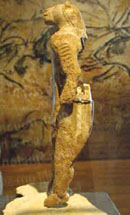



©1997-2003 VNN
|
WORLD Lion Man Oldest Statue FROM NATURE NEWS SERVICE  USA, Jan 1 (VNN) — Lion man takes pride of place as oldest statue USA, Jan 1 (VNN) — Lion man takes pride of place as oldest statue 30,000-year-old carving might be work of Neanderthals or modern humans. Rex Dalton Intricate ivory carvings said to be the oldest known examples of figurative art have been uncovered in a cave in southwestern Germany. Researchers say that the finding could change our understanding of early man's imaginative endeavours. The artefacts - including a figurine depicting a Lowenmensch ('lion man') - have been carbon-dated to around 30,000 years ago, when some of the earliest known relatives of modern humans populated Europe. Discovered last year by a team led by US archaeologist Nicholas Conard of the University of Tbingen in Germany, at the Hohle Fels cave near Ulm, the objects include figures depicting a horse and a bird. Conard says he thinks that the figures are older than a previously discovered Lowenmensch, fragments of which were found by German archaeologists in 1939 near Vogelherd and dated to about the same time. Until now, those artefacts were accepted as the oldest examples of figurative art in the world. The newly discovered objects are older, Conard argues, as they were uncovered at a lower level in the cave floor's sediments. "These discoveries have incredible significance," says Clive Gamble, an archaeologist at the University of Southampton, UK. "They depict the animal world in a semi-realistic way. It shows early man moving from his immediate world to an imaginative world." Conard reported the discovery on 30 July at the Sixteenth Congress of the International Quaternary Association in Reno, Nevada, during a lecture on the human colonization of Europe. He is now preparing a manuscript on the discovery for publication. Conard, who has studied human migration from Africa at dig sites stretching from Syria to Germany, believes that humans first arrived in central Europe by following the River Danube west into the area. The figurines add a new dimension to theories about the Danube route, agrees Gamble. "During the Ice Age in Europe, the frozen Danube would be like a highway," he says, "providing a fast track to new environments." Fossil remains suggest that modern humans and Neanderthals both lived in Europe during this period. Conard reported that the sedimentary levels in which the ivory carvings were embedded did not include any Neanderthal fossils. But some archaeologists argue that it is possible that the much-maligned Neanderthals produced similar objects. "I don't think that is as far-fetched as some people might think," says Jeffrey Brantingham, an archaeologist at the University of California, Los Angeles. "These objects are pushing the markers and traits" of modern man "further back into time", he says. Archaeologists have pointed out that beads, bone points and pendants have already been discovered in association with Neanderthal fossils. Attributing artefacts to one of the two hominid groups remains difficult, says Brantingham. Gamble says that the discovery will spur fresh exploration of France, Spain and South Africa, where even older cave drawings - but not figurative art of this age - have been identified. Rex Dalton is the West Coast Correspondent of the journal Nature. © Nature News Service / Macmillan Magazines Ltd 2003 Contact VNN about this story
|